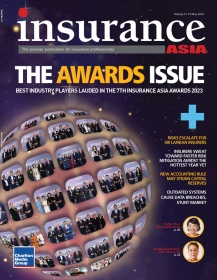
John Morley of Ernst & Young shares valuable insights on the financial and insurance industries
Like the French Revolution, he believes it's too early to tell what trends will play out long after the crisis.
John has over 25 years of insurance industry experience and currently leads the EY offering for finance transformation in Singapore, including IFRS 17 for insurance clients. He has worked directly for leading international insurers and reinsurers as well as other big four advisory firms.
His previous roles included global head of business process excellence and Business Process Reengineering, internally and with clients through the consulting division.
John, who holds a Ph.D. in Political Economy from the University of Bristol, has worked in Europe, North America and Asia.
As one of the speakers at the Insurance Asia Digital Conference, he gives some of his insights on why internal collaboration needs to be improved in financial service, what makes a successful finance transformation project, and why setting trends during the pandemic presents a high level of risk.
The competition for financial service clients has never been fiercer. How can the financial industry build--or increase--brand loyalty among its clients?
In the approach to building brand loyalty, a greater understanding of client buying and retention behaviour is essential. An insurer, both life and general, holds significant amounts of its own clients' data - unfortunately, they rarely use this fully or consistently to provide critical business insights.
One potential area of improvement is internal collaboration. Much of the client data is held by finance but most of the experience and expertise to analysing this client data sits within the actuarial and finance functions. So how can the finance function maximise their contribution as a value-adding business partner? By pooling the data, both structured and unstructured, and freeing up finance capacity to analyse and build scenarios on growth and retention.
What is finance transformation? And can it still play a huge role for financial industries even during the pandemic? If yes, in what way? If no, what are the causes for this?
Finance transformation has itself "transformed". Ten years ago, a finance transformation project involved replacing your Enterprise Resource Planning (core finance systems) with a newer version. This loses a lot of your custom functionality in the process and pays a lot to a systems integration firm for the privilege. Now, times are more competitive and as such, insurers require tangible value-add and measurable payback from any project-finance transformation being no exception.
A finance transformation project or program is therefore examined more holistically to ensure success. The focus falls on four aspects of the finance operating model; people and organisation, process and services, technology and finally data quality. Without all these aspects being matured in step, the full and lasting benefits of a finance transformation cannot be realized:
For people and organisations, silos often exist such as the division between accounting and actuarial which grew up in another age. To resolve this lack of information sharing, these silos need to be broken down and multi-disciplinary teams established. This will meet the analytical needs of the business in a more agile and forward-looking way.
The organisation must also become less process-focused and instead, strive to be more service-oriented. It is key to aim for an outcome-focused mindset rather than fixing or improving existing processes that were set up to meet the needs of a historic age.
Technology can be used to facilitate internal collaboration and complement outcome-focused mindsets. Many platforms and tools have matured and can be utilized to good effect in accounting standards and regulatory compliance projects. This can be found especially in sub-ledgers and cloud technology.
Last but not least, it is finally time to get a handle on that data! You will never fix it at source in older companies given multiple and aging policy administration and claims systems. So, pool what you have and where needed, conform it to a standard in one repository. This will then greatly ease the burden of reference to reconciliation.
What significant changes and trends happened to the insurance industry during the crisis?
Just like the French Revolution, the simple answer is that it's too early to tell. The COVID-19 crisis is unfortunately not over yet and as such the social, economic and cultural consequences will continue to play out long after the crisis ends. Therefore, jumping to conclusions now presents a high level of risk. That is why, we at EY, look at the effects in the now (immediate), the next (what will happen in the next year or two) and the beyond (what are the lasting and systemic changes):
In the Now
Despite this being a pandemic, effects have been more marked in the general insurance space. During lockdowns and even after hard lockdowns or circuit breakers, people are driving far less ergo they are also crashing far less. Some lines such as travel insurance have effectively disappeared at least in the short term. Overall, combined ratios are good but retention becomes a problem with less cover being contracted. This is why client access and an ability to close quickly are critical; insurers with a digital capability and those that can rapidly deploy one have a significant competitive edge. In the living space, the traditional face-to-face broker model has been heavily challenged. For insurers to gain an advantage, they have had to quickly and effectively implement an augmented digital model with the use of virtual needs assessment meetings but digital closure.
In the Next
As detailed above, providing some digital capability has provided insurers with a competitive advantage. At EY, we see this benefit as a current albeit short-lived differentiator in that smooth, seamless, and user-friendly digital access will soon need to be a Must-Have rather than a Nice to Have. In the post-COVID-19 movement and contact restrictions, we see that direct clients will expect a different way of interacting with insurers. Hence it will be crucial for the direct insurers to be increasingly open to providing digital channels and ensuring a positive and efficient user experience.
In the Beyond
Looking forward, it is expected to see the societal shift toward increased home working as well as a shift to more leisure and less business travel. This will lead to a request for different and more on-demand insurance products that are digitally supplied and activated. EY predicts that insurers who can adapt to providing these new products and use them to strengthen their clients' bonds with a refreshing customer journey will win out in the years to come.






















 Advertise
Advertise










